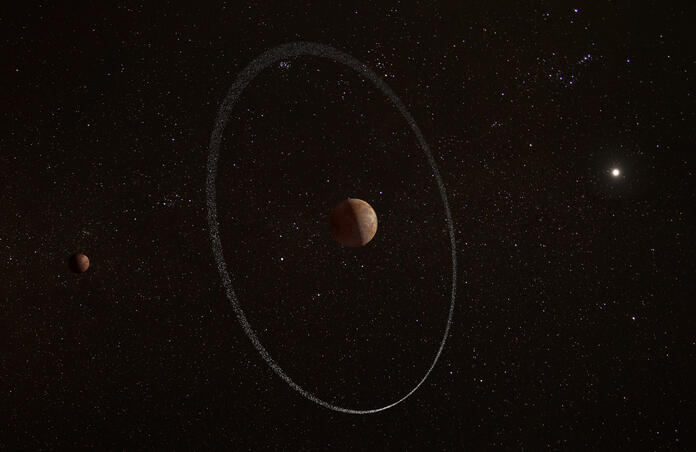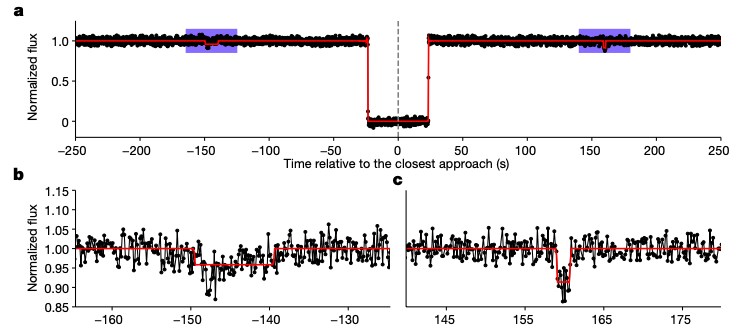Ring system discovered around dwarf planet – but should it be there?

A dwarf planet in our very own solar system has been discovered with a ring system that may defy physics. The mysterious planetesimal is named Quaoar, and is one of 3000 trans-Neptunian objects (TNO). This group of objects are home to the Kuiper belt, found beyond the orbit of Neptune, the outermost planet in the solar system. Quaoar is the 7th largest TNO with a radius of 555km and hosts a moon, Weywot.
Since rings are too faint and small to be observed directly through images, the method of occultations has to be used. Occultations occur when a planetary body passes in front of a star, therefore blocking some of the star's light momentarily. Observing the light from the occulted stars can reveal a lot of information about the occulting planet, such as its size, shape, and even if it has an atmosphere.
However, it is not easy to study such planetesimals, since they are very small with extremely far-out orbits. Therefore, although occultations are very useful, the difficulty lies in knowing when these events will happen. For an occultation to occur, there must be a precise alignment between an occulting object, a star and the observing telescope. Thus, to ensure the observation of these events, the European Research Council Lucky Star project was proposed to predict TNO occultations, and therefore coordinate observations using professional and amateur observatories globally. Thanks to ESA’s star mapping mission, Gaia, the number of observed occultations has recently increased. Gaia provides data with extremely accurate stellar coordinates, which increases the confidence of the occultation predictions.

The ring system was discovered through a number of observations carried out between 2018 to 2021, using a number of ground-based telescopes such as Gran Telescopio Canarias on La Palma, as well as ESA’s Characterising ExOPlanet Satellite (CHEOPS). The telescopes observed Quaoars occulting several different stars, monitoring the changes in starlight. The resulting light curves revealed two small dips either side of the main occultation, pointing towards the existence of material orbiting the planetary body. This is the first ever detection of a stellar occultation using a space telescope, which played a key role in eliminating the potential cause of the drops being attributed to spurious effects in earths atmosphere. "The Cheops data are amazing for signal to noise," explained Isabella Pagano, as astronomer at Italy's National Institute for Astrophysics (INAF) and member of the Cheops board. The signal to noise is a measure of how strong the detected signal is to the random noise in the system. Cheops gives a great signal to noise because the telescope is not looking through the distorting effects of Earth’s lower atmosphere."
Ring systems in our solar system are fairly uncommon, with well-known rings being hosted by Saturn, Jupiter, Uranus and Neptune. Along with this, only two other planetary bodies have rings – dwarf planets Chariklo and Haumea, both of which have been detected through ground-based telescopes. However, what makes Quaoars ring system unlike the others is the position at which the ring of material orbits, and particularly that this is found well outside of Quaoars roche limit.
Any astrophysical body with a gravitational field will have a limit within which another body will disintegrate – the roche limit. Dense rings of material are expected to exist inside of a planet's roche limit, which is the case for all other ring systems within our solar system. If the material is outside this limit, it is expected to fuse to form a small body such as a moon. However, Quaoars ring lies at a distance of over 7 times the planet's radii, which is twice as far as its roche limit. Therefore, this peculiarity has led astronomers to question why the material hasn’t coalesced under its own gravity to form a small moon akin to Weywot.
Professor Vik Dhillon, co-author of the study from the University of Sheffield's Department of Physics and Astronomy, said: "It was unexpected to discover this new ring system in our Solar System, and it was doubly unexpected to find the rings so far out from Quaoar, challenging our previous notions of how such rings form.
For now, the results point towards the arctic temperatures on Quaoar, which could prevent the icy particles from sticking together, however, further investigation is needed. The Lucky Star project will continue to study Quaoar and other TNOs occulting distant stars to investigate how many others have ring systems.
--
Cover image: ESA
Journal source: Morgado, B. E. et al. A dense ring of the trans-Neptunian object Quaoar outside its Roche limit. Nature, 2023; 614 (7947): 239 DOI: 10.1038/s41586-022-05629-6
